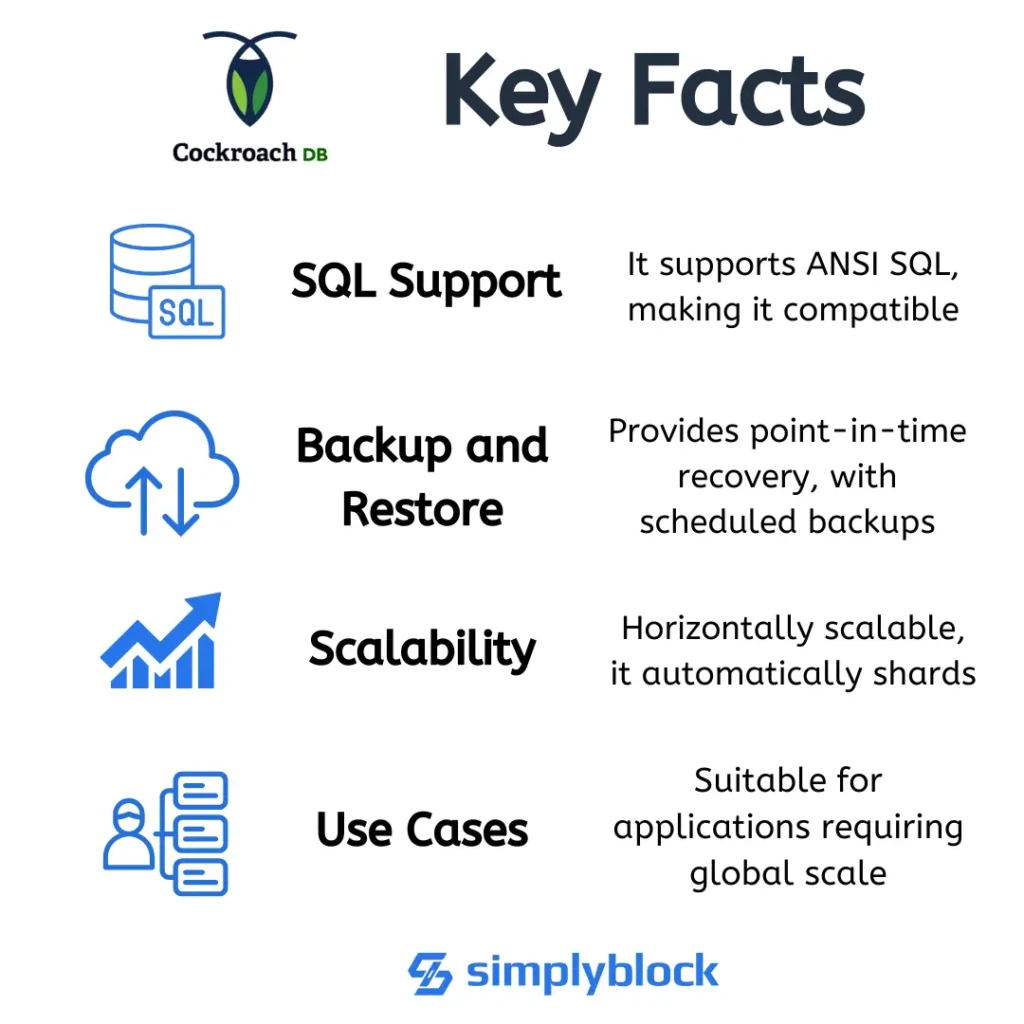CockroachDB
Terms related to simplyblock
What is CockroachDB?
CockroachDB is a distributed SQL database designed for cloud-native environments. Built with resilience and scalability in mind, it ensures consistent transactions across multiple nodes, making it ideal for modern, distributed applications. It provides a highly available, fault-tolerant architecture that supports multi-region deployments.
What is CockroachDB used for?
CockroachDB is primarily used for managing large-scale, distributed applications that require high availability and low-latency performance. It’s perfect for organizations handling mission-critical data across multiple regions, providing seamless replication and automated data recovery. Its SQL compatibility allows easy migration for teams already familiar with relational databases.
How does CockroachDB differ from traditional SQL databases?
CockroachDB stands out from traditional databases by offering distributed SQL capabilities. While traditional databases may face scalability and resilience issues when spread across multiple nodes or regions, CockroachDB’s architecture ensures horizontal scalability, meaning it can handle increased loads by simply adding more nodes to the cluster. Additionally, CockroachDB automates data distribution and recovery, making it more resilient to failures compared to monolithic databases.
Is CockroachDB better than PostgreSQL?
CockroachDB and PostgreSQL both offer SQL compatibility, but CockroachDB provides additional benefits in terms of distributed architecture and fault tolerance. CockroachDB’s ability to scale horizontally and its automatic failover system make it a preferred choice for cloud-native environments and global applications. PostgreSQL, while powerful, may require additional configurations and management to achieve similar levels of availability and scalability.
Why is CockroachDB popular for cloud-native applications?
CockroachDB’s cloud-native design is optimized for dynamic and distributed environments, making it popular for applications that require seamless scaling, fault tolerance, and real-time data replication across regions. Its SQL compatibility means developers don’t need to learn new query languages, making it a flexible and accessible choice for those transitioning from traditional databases.
CockroachDB vs. Kubernetes: What makes them a great pair?
CockroachDB can run effectively on Kubernetes, making it an ideal choice for containerized environments. Kubernetes provides orchestration, and CockroachDB’s distributed SQL capabilities ensure seamless scaling and resilience within this environment. Together, they form a highly available and scalable solution for deploying distributed applications.
What is CockroachDB performance tuning?
CockroachDB performance tuning involves optimizing query performance, managing node resources efficiently, and configuring the cluster for high availability. Ensuring proper node placement and monitoring resource usage are critical to optimizing CockroachDB’s performance in large-scale deployments.
How to optimize CockroachDB costs?
Optimizing CockroachDB costs involves using cloud infrastructure efficiently, scaling resources according to demand, and leveraging cost-effective storage solutions. Implementing performance optimization techniques, such as query tuning and load balancing, also helps reduce unnecessary overhead, ensuring CockroachDB deployments are cost-effective.
Is CockroachDB self-hosted?
Yes, CockroachDB can be self-hosted or deployed in cloud environments. Its flexible architecture allows teams to manage it on-premises or use managed services for more hands-off deployments. This flexibility makes CockroachDB adaptable to various business needs, offering full control over the database environment.

How does CockroachDB pricing work?
CockroachDB offers different pricing models, including cloud-based subscription plans or self-hosted licenses. Pricing varies depending on factors like the number of nodes, storage requirements, and additional services. For businesses seeking a cloud-native solution, CockroachDB offers flexible pricing based on consumption and scalability.
CockroachDB on Kubernetes
Running CockroachDB on Kubernetes involves managing stateful workloads, where Kubernetes StatefulSets provide stable network identities and persistent storage essential for data integrity across nodes. Each CockroachDB instance benefits from StatefulSets that ensure pods retain their unique identities, simplifying node replacement and enhancing data resilience. In this configuration, CockroachDB’s distributed SQL capabilities leverage Kubernetes’ built-in service discovery, while persistent volume claims (PVCs) offer dedicated storage for each pod, minimizing data loss risk during rescheduling.
Why Choose Simplyblock for Cockroach?
Simplyblock is designed to work seamlessly with Kubernetes, leveraging its simplyblock CSI driver to dynamically manage CockroachDB’s storage needs. This compatibility allows simplyblock to provide Kubernetes-native features like automatic provisioning, resizing, and snapshots, which makes handling CockroachDB’s stateful workloads straightforward. For CockroachDB’s specific needs, simplyblock’s NVMe-backed storage pools allow for persistent, low-latency access, ensuring that reads and writes happen as close to the data as possible. The architecture’s support for logical volume management further enables CockroachDB deployments to scale storage independently of compute, optimizing storage costs and resource usage—perfect for Kubernetes environments where CockroachDB pods might experience fluctuating demand.
How to optimize CockroachDB cost and performance?
Optimizing CockroachDB in Kubernetes costs on the cloud is critical. Simplyblock bridges local NVMe, block storage, and object storage into a unified storage system, enabling high performance at lower costs. By leveraging thin provisioning and intelligent tiering, simplyblock ensures only actively used data remains on NVMe, while cooler data moves to cost-efficient, object-based storage. This design allows for up to 80% savings on storage costs and maintains low latency through NVMe over TCP, making it ideal for CockroachDB’s demands on Kubernetes.
Simplyblock further reduces storage costs through erasure coding, achieving fault tolerance with minimal data redundancy—a more efficient alternative to replica-based methods. This architecture is purpose-built to deliver local-like performance with the scalability and resilience required for dynamic Kubernetes environments on the cloud, supporting CockroachDB’s performance needs in a cost-efficient way.
Simplyblock also includes additional features such as instant snapshots (full and incremental), copy-on-write clones, thin provisioning, compression, encryption, and many more – in short, there are many ways in which simplyblock can help you optimize your cloud costs. Get started using simplyblock right now and if you are on AWS, find us on the AWS Marketplace.
